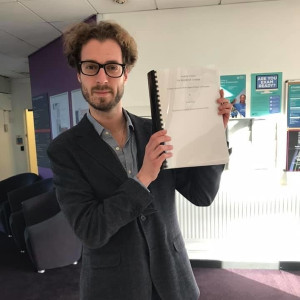Chapters
They say that writers should write what they know. That's the Number One piece of advice doled out in writers' workshops. At least at the start, writers should pen their thoughts on a subject or event entirely familiar to them. Maybe that advice is intended to mean 'just until the creative juices get flowing'. For many authors, that certainly seems to be the case. There's no way that Sci-Fi writers could have experienced what they write about.
Thomas Hardy obviously does not follow that edict. The stories he wrote and the poetry he composed are completely opposite to what the historical record shows about his life. Unlike Charlotte Mew, who had just come to prominence as our author was turning out more poetry, Mr Hardy did not live a fraught, outrageous life. At least, not publicly.
What prompted him to write the scandalous prose he set to paper, then? How could he pen such convincingly mournful poetry at such a young, apparently inexperienced age? We need to understand:
- the author's drive to live a quiet, pastoral life
- the sense of sorrow behind his tragic, often elegiac works
- why Neutral Tones stands out
- the features that make this poem so remarkable.

Thomas Hardy: Mini-Biography
He was born into a working-class family, three years into the Victorian Era. By all accounts, it was a loving, nurturing family. His father was a stonemason; his mother was well-educated. She led his early education, meaning that he did not attend school until he was eight years old.
He showed great academic potential but the family was poor. They could not afford to send him to university. At age 16, he started an apprenticeship under a local architect, James Hicks. Six years later, he moved to London to attend King's College. He won prizes and recognition for his architectural work. Soon, he was working on projects all over London.

But he never felt at ease there. He was painfully aware of his lower-class status; he couldn't help noticing how those of 'inferior birth' were treated. After five years in London, he returned to country life, citing health concerns as his reason for cutting short his promising big-city architectural career.
But his time in London wasn't all about architecture. Perhaps spurred by his feelings of inadequacy, he became interested in social reform. Writings by philosophers such as John Stuart Mill and Auguste Comte had a profound effect on him. Indeed, he professed On Liberty, a Mills essay, was his philosophical and practical aspiration.
This author was one of the most successful novelists of the nineteenth century. He wrote challenging, popular stories such as Tess of the D'Urbervilles and Jude the Obscure. These tales and others he wrote explore the depth of emotions in human relationships within the setting of the natural landscape. More importantly, though: they're written under the gloom of class disparity, a condition that plagued him from his early adolescence.
Neutral Tones
The lack of public-facing, scandalous outrage in this poet's biography points to a vivid inner landscape. Like Romantic poet Percy Bysshe Shelley, Thomas Hardy's written words did not match his public persona. However, this poem's very private tenor perhaps shows that this writer preferred keeping his affairs to himself. It feels almost as though the reader were a voyeur who had stumbled upon a breakup scene and keenly stayed to watch.
Neutral Tones
We stood by a pond that winter day,
And the sun was white, as though chidden of God,
And a few leaves lay on the starving sod;
They had fallen from an ash, and were gray.
Your eyes on me were as eyes that rove
Over tedious riddles of years ago;
And some words played between us to and fro
On which lost the more by our love.
The smile on your mouth was the deadest thing
Alive enough to have strength to die;
And a grin of bitterness swept thereby
Like an ominous bird a-wing...
Since then, keen lessons that love deceives,
And wrings with wrong, have shaped to me
Your face, and the God-curst sun, and a tree,
And a pond edged with grayish leaves.
What is it About?
Neutral Tones is a love poem. But it focuses on the sadness at the end of a relationship rather than the joy a fresh, new love brings. It has a hint of tenderness mixed with deep regret and even bitterness. It's packed with poetic devices and natural imagery. The four short stanzas make a powerfully emotional piece of poetry.
Tone
The title gives a clue that this poem is not full of exuberant emotion or traumatic heartbreak. The writer's tenor is "neutral" and unemotional, as the two lovers' timbre was likely to be during their discussion. The verses' uneven rhythm conveys the unsteady emotional terrain, much as a tenuously tethered boat might rock on choppy waters.
One of the ways Hardy achieves tonal neutrality is by giving details to the setting in short, simple phrases. They build up a picture without giving details or describing the person he addresses. For example, the first line sets a very plain scene on a day that the poet expects his listener to remember ("that day"). He adds a detail almost as an afterthought, "And the sun was white", and then another, "And a few leaves lay on the starving sod".
He uses non-specific determiners - "a few" and "some" to show that he did not care enough to count or to remember the details. Or perhaps the memory is too painful for him to try to remember the details? He writes "And some words played between us to and fro". It is as though his lover's eyes and their walk were the main features. Their conversation was just an extra feature, the words of which he isn't even interested.
Yet these were the words that brought an end to their love. When they both discussed which of them had "lost the more by our love". He inevitably concludes that love deceives, making an absolute declaration about a situation he cares little to remember the details of.

Natural and Colour Imagery
An alternate meaning of the title is "weak colours". If we list the colours in the poem we find simple colours drawn from a very restricted palette; white, grey and greyish. Yes, these colours all match the setting of "that winter day". But Hardy uses his writer's prerogative to choose what to show his reader. He ensures that the natural world in the poem reflects the dull, deadened emotions of the heartbroken couple.
He is rightly famed for his powers of observation. The leaves of ash trees, when they fall, are indeed grey, not brown. This detail satisfies his rhyme scheme and continues his colour scheme. It proves that he is readier to remember the details of the surroundings than the content of the conversation.
The lover's mouth movement is almost brought to life - but in the weakest possible way. It is described as "the deadest thing | Alive enough to have strength to die". Not only is this display fake, but it seems to sap the colour from the things around it. The "grin" that passes across her face might remind us of a skull's grin, in the context of the morbid talk. The bird that he compares it to is the "ominous" bird that would have been read by a soothsayer to indicate someone's fate or doom.
Language
The poet uses several terms which have old-fashioned meanings. He was very interested in etymology and the history of language. He added overtones to his writing by using these meanings.
For example, in the fourth stanza, he explains that since the walk by the pond, he has experienced "keen lessons that love deceives". "Keen" originally meant "sharp", so the poet is describing this learning as "cutting". He implies that he now believes love tricks the lover.
"Chidden" is the past participle of "to chide", meaning "to rebuke" or "to tell off". By using slightly archaic verb forms in this manner, he could elevate the tenor of his poem to sound more timeless and more serious. In this form, the verb sounds more contemptuous. A word spat out under duress, cloaked in bitterness. One so unsavoury that it must be quickly gobbed out.
Drawing God into the telling of this reminiscence does the same thing. When he refers to God it is exclusively as a judge: God "chides" the sun and has "curst" the sun. The figure of a wrathful deity beyond the natural world recurs in Hardy's writing, usually to drain hope from a situation.
The 'starving sod' is a powerfully alliterative noun phrase; it adds to the sense of cold through its sibilance. Today, 'starving' means "hungry" or "dying of hunger". But it used to mean "dying" of any cause; it had much more finality than the current definition. There was no way back from "starving", just as there is no way back for this relationship.
Form
The poem has four stanzas of four lines - quatrains. These are rhymed in an ABBA pattern, which had become associated with Tennyson's In Memoriam published in 1949. Hardy was certainly aware of the best-selling elegy, but he has adapted the form. Instead of using four lines with four strong beats each (tetrameters), he shortens the fourth so it has only three strong beats (a trimeter).
The pattern of three iambic tetrameters followed by a trimeter was common in folk poetry. It is known as 'long metre' when rhymed ABAB or xAxA. However, this doesn't quite fit this work's metrical scheme either. Throughout his career, this writer was a considerable innovator of metrical forms.
He often experimented with new patterns and rhythms to see what effect they would have on his writing. In the case of Neutral Tones, the arch-rhyme scheme of ABBA borrows the sombreness of an elegy. Complementing that darkness, the rhythmic pattern similar to a long meter helps tell a story in simple language. Much like Irish poet Seamus Heaney, Hardy preferred to use direct expression whenever possible.
Themes Addressed
Betrayal drives this narrative. The writer tries hard to disguise his devastation at her presumed disloyalty by covering it with all manner of things in neutral colours. But his bitterness shines through, even as he makes every detail insignificant. Or maybe because of it.
If betrayal is the driver, deceit must be this poem's navigator. The starkness of the tableau - the dead leaves, the starving ground... They all point to the depth of the presumed deception. We see it in her searching eyes; orbs that, presumably, looked upon him much more fondly at one time. The writer makes it appear as though she couldn't even fathom the depth of his grief. What a cruel, calculating deceiver she must be!
Inequality features, as well. However, it's not social inequality but the emotional variety that guts this narrator. How could this remote lover muster only enough of a smile for it to die? We may intuit that forming of lips as more contemptuous than sorrowful. This work tells us nothing about the other person; that too is an expression of inequality.
Memory is a persistent theme in this poem. In Hardy's retelling, these events have been bleached of every visual element he describes. In that sense, this poem contrasts vividly with Robert Minhinnick's Yellow Palm. The narrator only remembers a few details; they have been "shaped" by hindsight and his cynicism. This means that when he returns to his visual imagery at the end of the poem, it has only become harsher. Now the sun is "curst", not just "chidden".

Summary: Neutral Tones
This poem has none of the stop-motion imagery of the Ted Hughes poem, Bayonet Charge. Instead of a rapid-fire collection of impressions, Hardy treats his readers to a lingering glance at a dying world. Implicit in nature's detritus of death - the ashen leaves and starving sod, lies love, irrevocably gone.
The writer is the narrator. He plays the part of the aggrieved party, cutting his erstwhile partner with the bitterness of his expression. He dismisses her by dismissing all the details that made their relationship real. Conversations become 'some words played between us'. Her smile, a mere ghost of the one that likely graced her mouth in happier times.
We don't know why the affair ended or who might have been at fault. But it's clear the narrator doesn't blame himself. He may not blame his former lover, either. There are no accusations, only implications. Her eyes are disinterested, her mouth is devoid of liveliness. The knowledge that love deceives: he leaves us with the impression that he loved fully but she was less than inclined to do so.
Neutral Tones has four stanzas of four lines each but they do not evenly rhyme. For each verse, the first three lines are iambic tetrameters; the closing line is a trimeter. The writer uses no enjambments to entice the eye further. Each stanza is a complete expression that invites the reader to dwell on the exposed cruelty before moving on for another dose of the same.
Hardy uses sibilance to project spitting bitterness. 'Starving sod' is one example of such. And then, though not an alliteration, he distributes that sound across each line of the fourth verse. That seems to ensure the bitter sentiment conveys all the way through the poem.
He also resorts to archaic vocabulary to make his depictions harsher. "... as though chided by God" sounds regretful. "...as though chidded by God" is forceful, nearly contemptuous in its resonance. In the last stanza, he refers to the "God curst sun". Again, this is intended to convey contempt and bitterness; the standard '-ed' ending would not have affected the verse's meter.
The third stanza includes one simile: "Like an ominous bird a-wing". It is uniquely well-placed because that particular set of lines invokes life and death in equal measures. The smirk that was the deadest thing; it was only alive enough to die. In Roman times, oracles studied the birds' flight to divine the will of the gods. This bird is ominous - not frivolous. It tilts the verse's intent towards death.
As in Carol Ann Duffy's poem Medusa, so too in Neutral Tones. The title appears nowhere in the poem but they don't need to. The writer paints everything in neutral colours. He makes the landscape as bleak and monochrome as possible.
Hardy married relatively late, at 30 years old. He stretched his courtship over four years, perhaps indicating that he wanted to avoid any personal entanglements. The marriage endured until his wife's death, though their relationship became strained in later years. After her death, he became besotted with grief, roaming all over Cornwall to revisit scenes of their courtship.
By the start of the 20th Century, he became better known for his poetry. He often incorporated love and abandonment, and social injustice as themes. However, he had been writing verses since he first put pen to paper. This poem was written in 1867 when he was just 27; a full three years before he met and married Emma Gifford.
Knowing this bit of his history, it seems as though Neutral Tones might have been written about Emma passing on; their final parting. After all, this poem evokes a lot of death imagery. At the very least, it seems eerily prescient. The depth of feeling this poem conveys shows it's likely based on his own experience; a breakup he suffered out of the public eye.
Most attribute this work to his parting from a young woman named Tryphena Sparks. She was an immediate relative of his; the family strongly disapproved of his relationship with her. Perhaps his personal feelings of inferiority also caused so many of his early relationships to go awry. Even his marriage to Emma ended up fracturing. Maybe Thomas Hardy was telling more than he let on with that final stanza's first line. The one that reads "Since then, keen lessons that love deceives"...















You state” Our narrator was instrumental in moving the St Pancras church cemetery to make way for the St Pancras station railway. ” This is incorrect because it equates the writer Thomas Hardy with the narrator of the poem. J’est un autre as Rimbaud says.